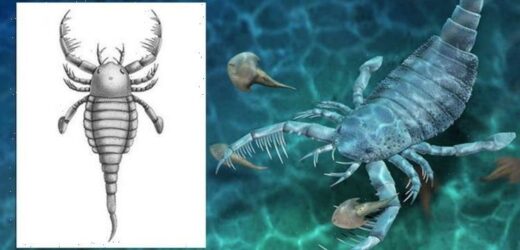Brindabellaspis: Scan shows fossil of ancient 'platypus fish'
We use your sign-up to provide content in ways you’ve consented to and to improve our understanding of you. This may include adverts from us and 3rd parties based on our understanding. You can unsubscribe at any time. More info
The terrifying creature was fairly large, by modern standards, measuring about 3.2ft (one metre) from tip to tail. By comparison, the Giant Forest Scorpion (Heterometrus swammerdami) holds the world record for biggest scorpion at just nine inches (23cm) in length. The newly discovered creature belonged to a family of so-called eurypterids – an extinct family of sea scorpions that appeared emerged nearly 500 million years ago.
Eurypterids appeared during the Ordovician period before peaking in diversity during the Silurian.
By the end of the Permian (298.9 to 251 million years ago), the sea creatures were virtually extinct.
The newest member of the family belonged to a class of eurypterids known as mixopterids.
These sea-dwelling creatures were characterised by prominent appendages used to ensure their pray like a “catching basket”.


Lined with multiple, razor-sharp spikes, the mixopterid skewered any hapless victim that ventured a bit too close.
The “sharp weapon” may have allowed the creature to be one of the top predators of its day.
An international team of researchers at the Nanjing Institute of Geology and Palaeontology of the Chinese Academy of Sciences (NIGPAS) named the creature Terropterus xiushanensis.
The researchers wrote: “One of the most remarkable eurypterid families is Mixopteridae, whose members are quite large and superficially scorpion-like eurypterids bearing highly specialized anterior appendages.
Flinders University make ancient fish fossil discovery
“Their second, and especially the third, pair of promosomal limbs are enlarged and very spiny.
“These limbs were presumably used for prey-capture, and analogies can be drawn with the “cathing basket” formed by the spiny pedipalps of whip spiders among the arachnids.”
The T.xiushanensis has been dated to the Lower Silurian of South China and appears to be the first known mixopterid of Gondwana, a supercontinent that began to break up during the Jurassic.
The creature’s discovery will be published in the November 30 issue of the Science Bulletin.


The study’s authors wrote: “Our knowledge of these bizarre animals is limited to only four species in two genera described 80 years ago: Mixopterus kiaeri from Norway, Mixopterus multispinosus from New York, Mixopterus simonsoni from Estonia and Lanarkopterus dolichoschelus from Scotland.”
The discovery will help scientists better understand the complex evolutionary diversity of the creatures.
Some modern-day relatives include the arachnids and the sea-dwelling horseshoe crab.
Large predators like the T.xiushanensis have not yet been found in the fossil record of South China’s Early Silurian environment.
Scientists have also recently discovered the fossil of a tiny dinosaur related to the mighty Tyrannosaurus rex.
The chicken-sized dino was found in a quarry in south Wales and is estimated to have lived 200 million years ago.
Named Pendraig milnerae, the species was named after the Welsh words for “chief dragon” and Dr Angela Milner who helped describe the dinosaur.
Dr Stephan Spiekman, a Research Fellow at the Natural History Museum, said: “It’s clear from the bones we have that it was a meat-eater, but early in the evolution of this group these animals were quite small, in contrast to the very famous meat-eating dinosaurs like T-Rex which evolved much later.”
Source: Read Full Article


